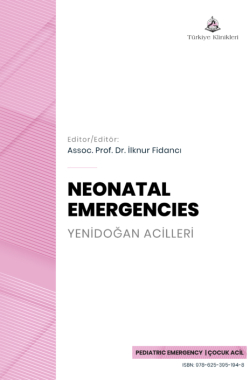Treatment of Neonatal Dehydration and Electrolyte Disorders
Melda TAŞa
aUniversity of Health Sciences Ankara Training and Research Hospital, Clinic of Neonatology, Ankara, Türkiye
Taş M. Treatment of neonatal dehydration and electrolyte disorders. In: Fidancı İ, ed. Neonatal Emergencies. 1st ed. Ankara: Türkiye Klinikleri; 2024. p.84-8.
ABSTRACT
Neonatal dehydration is associated with high morbidity and mortality rates. One of the main causes is inadequate breastfeeding, which may lead to fluid and electrolyte dysregulation and lead to serious complications. Seizures, thrombosis, encephalopathy, and even death may occur in infants with poorly managed and inadequately treated fluid-electrolyte disorders. Especially hypernatremia due to dehydration is more common. It is important to monitor the weight of the babies and to observe biochemical markers in those with high weight loss. Newborns in need of fluid electrolyte support should be evaluated by physical examination and other parameters (low urine volume, high urine density, high serum Na+) and treatment should be started rapidly.
Keywords: Hypernatremia; dehydration; water-electrolyte imbalance
Kaynak Göster
Referanslar
- Moritz ML, Manole MD, Bogen DL, Ayus JC. Breastfeeding-associated hypernatremia: are we missing the diagnosis? Pediatrics. 2005;116(3):e343-7. [Crossref] [PubMed]
- Djamila B, Aouicha, Z, Izdihar B. Dehydration in newborns admitted to intensive care for ehs nouar fadela. European Journal of Clinical Medicine. 2022; 3(4):11-3. [Crossref]
- Rawat A, Lakhkar BB, Karotkar S, Lakra MS, Kantode VV, Wanjari MB. Femoral Artery Thrombosis: Rare Sequelae of a Common Entity. Cureus. 2022;14(12):e32372. [Crossref]
- Bajaj M, Chiranth R, Mahajan S, Chauhan P. Clinical profile and outcome of neonates admitted in sick newborn care unit with hypernatremic dehydration and association with breastfeeding in a tertiary care hospital in northern India. International Journal of Contemporary Pediatrics. 2021;8(6):1074. [Crossref]
- Wright JC, Posencheg MA, Seri I, Evans JR. Fluid, Electrolyte, and Acid-Base Balance. In: Gleason CA, Juul SE, eds. Avery's diseases of the newborn. 10th ed. Philadelphia: Elsevier Saunders; 2018. p.368-89. [Crossref]
- Quigley R. Renal aspects of sodium metabolism in the fetus and neonate. In: Oh W, Baum M, Polin RA, eds. Nephrology and fluid/electrolyte physiology neonatology questions and controversies. 3rd ed. Philadelphia: Elsevier; 2019. p.47-63. [Crossref]
- Polin R, Abman S. Fetal and neonatal physiology. 4th ed. Saunders; 2011. [Crossref]
- Shaffer SG, Meade VM. Sodium balance and extracellular volume regulation in very low birth weight infants. J Pediatr. 1989;115(2):285-90. [Crossref] [PubMed]
- van Dommelen P, van Wouwe JP, Breuning- Boers JM, van Buuren S, Verkerk PH. Reference chart for relative weight change to detect hypernatremic dehydration. Arch Dis Child. 2007;92(6):490-4. [Crossref] [PubMed] [PMC]
- Modi N. Fluid and electrolyte balance. In: Rennie JM, ed. Rennie and Roberton's Textbook of Neonatology. 5th ed. Churchill Livingstone Elsevier, 2012. p.331-43. [Crossref]
- Gomella TL, Eyal FG. Bany-Mohammed F. Neonatology: Management, Procedures, On-Call, problems. Diseases, and Drugs. 8th ed. Mc Graw Hill & Lange; 2020. p.117-25.
- Modi N, Smeulders N, Wilcox DT. Disorders of the kidney and urinary tract. In: Rennie JM, ed. Rennie and Roberton's Textbook of Neonatology. 5th ed. Churchill Livingstone Elsevier; 2012:927-52. [Crossref]
- Dewey KG, Nommsen-Rivers LA, Heinig MJ, Cohen RJ. Risk factors for suboptimal infant breastfeeding behavior, delayed onset of lactation, and excess neonatal weight loss. Pediatrics. 2003;112(3 Pt 1):607. [Crossref] [PubMed]
- Taylor D, Durward A. Pouring salt on troubled waters. Arch Dis Child. 2004;89(5):411-4. [Crossref] [PubMed] [PMC]
- Harding D, Moxham J, Cairns P. Weighing alone will not prevent hypernatremic dehydration. Arch Dis Child Fetal Neonatal Ed. 2003;88(4):F349. [Crossref] [PubMed] [PMC]
- Neifert MR. Prevention of breastfeeding tragedies. Pediatr Clin North Am. 2001; 48(2):273-97. [Crossref] [PubMed]
- Choong K, Kho ME, Menon K, Bohn D. Hypotonic versus isotonic saline in hospitalized children: a systematic review. Arch Dis Child. 2006;91(10):828-35. [Crossref] [PubMed] [PMC]
- Coulthard MG. Will changing maintenance 71 intravenous fluid from 0.18% to 0.45% saline do more harm than good? Arch Dis Child. 2008;93(4):335-40. [Crossref] [PubMed]
- Greenbaum LA. Electrolyte and acid-base disorders. In: Kliegman RM, St Geme III JW, Blum N, Shah S, Tasker RC, Wilson K, et al., eds. Nelson Textbook of Pediatrics. 21st ed. Philadelphia: Elsevier; 2020. p.389-424.
- Namgung R,Tsang RC. Perinatal calcium and phosphorus metabolism. In: Oh W, Guignard JP, Baumgart S, eds, Polin RA (consulting ed). Nephrology and fluid/electrolyte physiology, neonatology questions and controversies. 3rd ed. Philadelphia: Elsevier; 2019. p.65-84.
- Abrams SA, Tiosano D. Disorders of calcium, phosphorus, and magnesium metabolism in the neonate. In: Martin RJ, Fanaroff AA, Walsh MC, eds. Fanaroff and Martin's neonatal perinatal medicine- diseases of the fetus and infant. 11th ed. Philadelphia: Elsevier; 2020. p.1611-42.
- Ringer S. Fluid and electrolyte therapy in newborns. In: Up-ToDate, Abrams SA, Mattoo TK, eds. UpToDate. 2020.

